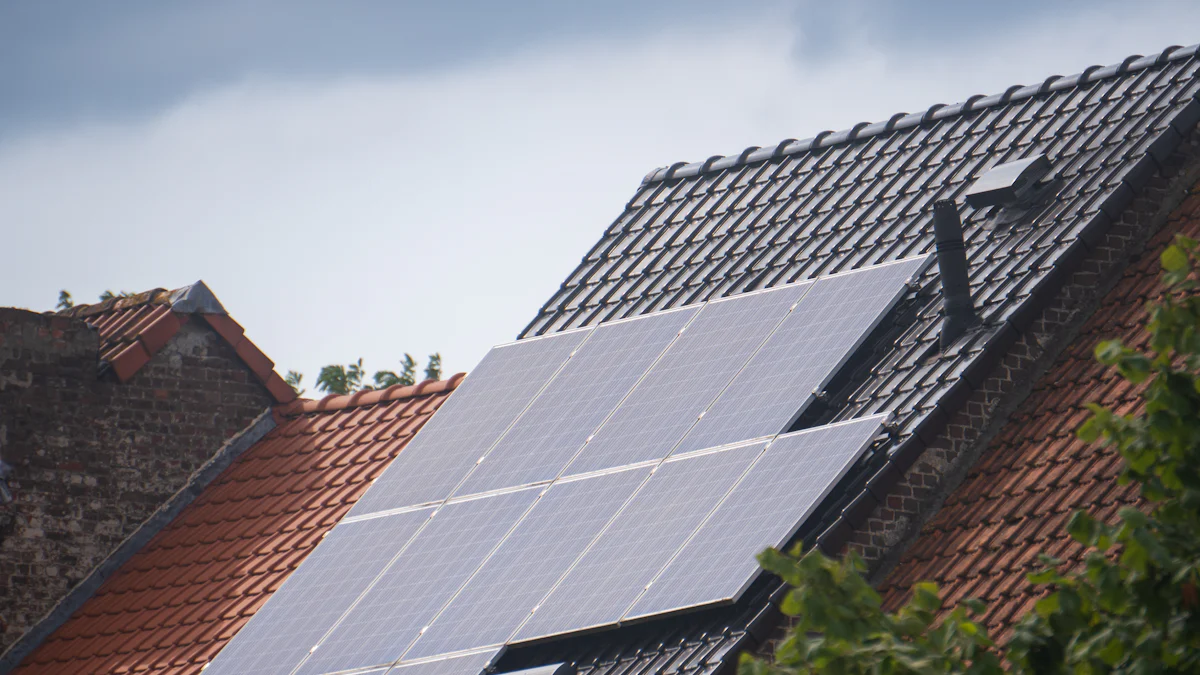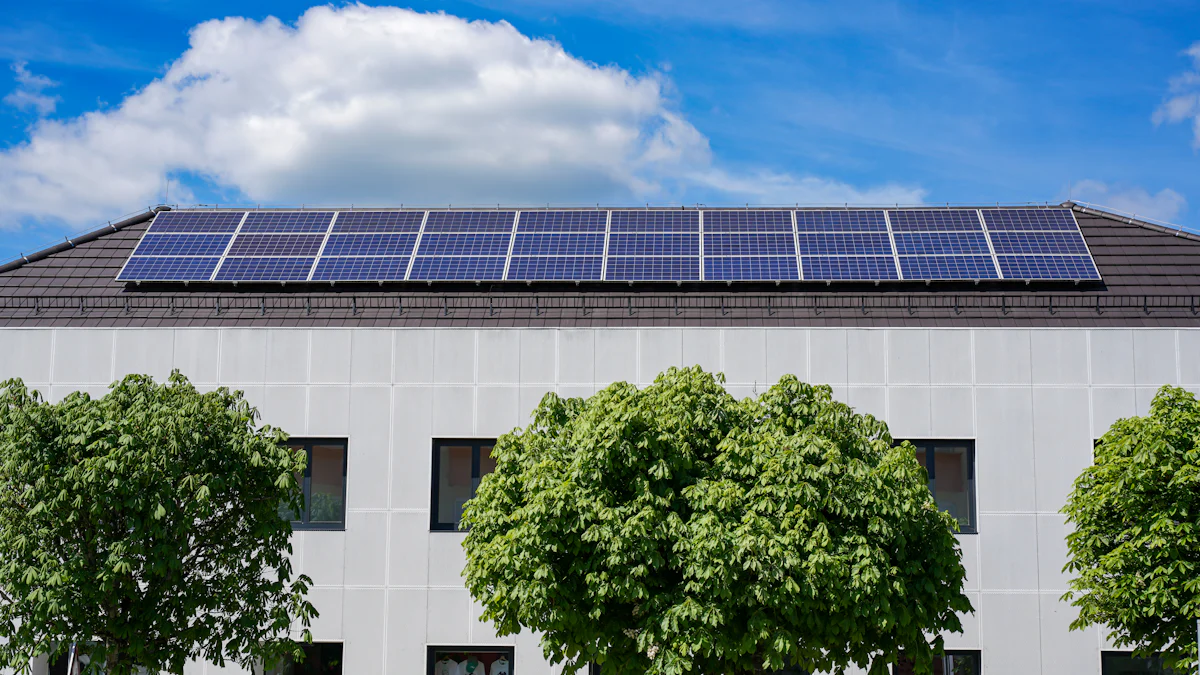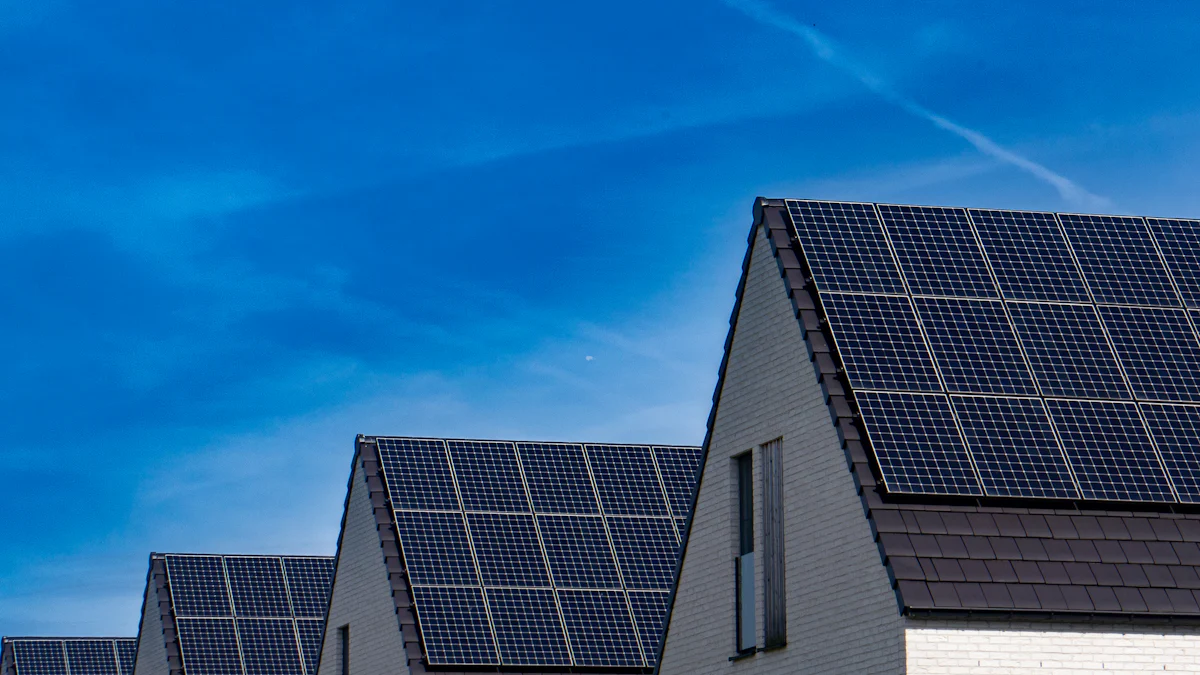Smart Roofing Trends for Modern Homes

Keeping up with roofing industry trends for 2025 helps your home stay modern, energy-saving, and attractive. Roof designs now mix smart technology with eco-friendly materials, and energy-efficient roofing materials. For example, green roofs are popular in cities. They keep homes warm, cut energy bills, and support plants and animals. Smart roofs with IoT systems let you check your roof anytime. They also predict problems early, saving money and making roofs last longer.
Smart roofs bounce sunlight away and let heat escape. This lowers cooling costs and keeps your home comfy. These ideas save energy and help the planet.
A reliable roofing contractor is essential for implementing these new ideas. They guide you on options like solar shingles. These shingles generate energy and lower pollution. By working with home services local to your area, you can prepare your home with the latest roofing solutions.
Key Takeaways
Learn about new roofing ideas for 2025. They can save energy and make your home look better.
Think about green roofs in cities. They help with rainwater, clean the air, and keep homes warm or cool. They are a good choice.
Look into solar roofs like solar shingles. They make power, cut costs, and match your home's style.
Use smart roof tools like IoT systems and drones. These help check your roof and keep it in great shape.
Pick eco-friendly materials like recycled shingles. They help the planet and support green building.
Sustainability and Eco-Friendly Roofing Trends

Green Roofs
Benefits for urban environments and energy efficiency
Green roofs are great for cities and help with water control. They soak up rain, stop flooding, and cut runoff. In summer, they hold up to 90% of rainwater. In winter, they keep 25-40%, making them useful year-round. Green roofs clean the air by trapping bad gases and dirt. They also cool cities by lowering heat from buildings and streets.
Benefit | Description |
|---|---|
Stormwater Management | Soil soaks up rain, cutting down on water runoff. |
Improved Air Quality | Plants clean the air by removing harmful gases. |
Urban Heat Island Mitigation | Green roofs cool cities by reducing heat from buildings. |
Biodiversity | They create homes for birds, butterflies, and insects. |
Green roofs cost more at first but save money later. They last twice as long as regular roofs and lower energy bills. This makes them a smart and eco-friendly choice for the future.
How they align with sustainable roofing options
Green roofs fit well with eco-friendly ideas. They save energy by keeping buildings warm in winter and cool in summer. They also help nature by giving homes to animals and cutting pollution. Many cities now give rewards for adding green roofs, making them a good pick for homeowners.
Solar Roofing
Integration of solar panels and solar shingles
Solar roofs have improved a lot over time. New solar shingles look like regular roof tiles but make energy. Photovoltaic (PV) shingles collect sunlight and look stylish. Thin-film solar systems can fit many roof shapes, making them flexible for different designs.
Type of Solar Shingle | Key Features |
|---|---|
Traditional Solar Shingles | Look like asphalt shingles, protect roofs, and make energy. |
Photovoltaic (PV) Solar Shingles | Use PV cells, look nice, and are good for the planet. |
Shingle-sized Solid Panels | Mix regular materials with PV cells, strong in bad weather. |
Semi-rigid Design Solar Shingles | Bendable, fit odd roof shapes, and work well. |
Thin-film Solar Cell Systems | Flexible PV material, works with many roof types. |
Environmental and cost-saving benefits
Solar roofs let you make your own power, cutting energy bills. Extra power can be sold back, saving even more money. Over time, these savings cover the starting cost. Solar roofs also keep homes warm in winter and cool in summer. They save energy and help protect the environment.
Recycled and Sustainable Materials
Use of recycled shingles and synthetic materials
Recycled roofing uses old materials like asphalt or rubber. This keeps trash out of landfills and saves resources. Synthetic shingles look like regular ones but last longer and need less care.
Reducing waste and carbon footprint
Recycled materials lower the carbon footprint of building projects. Reusing old stuff means less need for new materials. This helps the planet and inspires new eco-friendly ideas. Picking recycled or green materials for your roof is good for the Earth and supports eco-friendly building.
Smart Roofing Technologies
IoT-Enabled Roofs-Tech-Driven Roofing Solutions
Real-time monitoring and smart sensors
IoT roofs use smart tech to watch your roof's health. Sensors check temperature, humidity, and roof strength. You get updates instantly, so you can fix problems early. Alerts warn you if something, like high humidity, is wrong. This system means fewer inspections and keeps your roof in great shape. These smart roofs work for homes and businesses, making them useful and modern.
Smart Technology and iot Features
IoT roofs save money by spotting issues early. They send alerts for quick fixes, avoiding big repairs. These systems track data, cutting down on manual checks. With this tech, your roof lasts longer and needs less care. It’s a smart way to have a strong and low-maintenance roof.
Drones in Roofing
Enhancing safety and efficiency in inspections
Drones make roof checks safer and faster. Workers don’t need to climb ladders or steep roofs, avoiding accidents. Drones reach tricky spots, checking every part of the roof. This tech keeps workers safe and lowers risks for contractors.
Precision mapping for roofing projects
Drones give clear pictures and details for roof work. They find small damage early, saving money on repairs. Faster checks mean less time and lower costs. Drones also map roofs accurately, helping with repair plans. With up to 99% accuracy, drones make roofing projects precise and well-planned.
Benefit | Description |
|---|---|
Minimize work site mishaps | Drones safely inspect roofs, reducing worker accidents. |
Decrease inspection time | Drones check roofs quickly, saving time and cutting costs. |
Inspections accuracy up to 99% | Drones give exact data, avoiding mistakes and rechecks. |
AI-Powered Tools
AI-driven roofing estimates and planning
AI tools make roofing estimates easy and accurate. They adjust costs as prices change, avoiding mistakes. AI suggests better materials or methods to save money. Apps using AI give secure and trusted cost estimates, helping you decide confidently.
Streamlining roofing contractor services
AI helps contractors by automating tasks like schedules and payments. Chatbots answer questions anytime, keeping customers happy. AI assigns workers based on who’s free and nearby, saving time. Follow-ups are automatic, so no client is missed. Contractors can focus on good work while AI handles the rest.
Advanced Roofing Materials
Climate-Resilient Materials
Fireproof and weather-resistant options
Roofing materials now handle tough weather and fires better. Fire-resistant roofing slow fire spread, great for wildfire areas. Hurricane-proof roofs block strong winds and flying objects. Hail-resistant roofs stop damage from hailstones. Wind-resistant designs keep roofs secure during storms. These materials protect homes and reduce roof replacements.
Eco-friendly options like recycled metal and cool roof layers are common. These reflect sunlight, keeping homes cooler and saving energy. Choosing these materials makes your home safer and more eco-friendly.
Solutions for extreme weather conditions
Strong materials work well in bad weather. Metal Roofs with advanced coatings resist fire and water, saving money. Fluid-applied flashing seals tightly and moves with the building. Carbon fiber materials are strong and don’t rust. These options keep roofs safe and strong during extreme weather.
Durable and Insulated Options
High-performance materials for longevity
Long-lasting roofs, like metal ones, can last 50+ years. They handle bad weather and need fewer repairs. Low-maintenance roofs save time and money, making them a smart choice. These materials keep roofs strong for many years.
Insulated systems for energy efficiency
Insulated roofs save energy by stopping heat transfer. They block air leaks and keep homes comfy all year. These roofs lower HVAC use, cutting energy bills. They also help HVAC systems last longer.
Synthetic Shake and Slate Roofing
Aesthetic appeal with enhanced durability
Synthetic shake roofing and slate roofs look nice and are strong. They mimic traditional roofs but resist fire, mold, and pests. They are lightweight, reducing stress on buildings and making installation easier.
Low-maintenance alternatives to traditional materials
Synthetic roofs need little care, saving money on upkeep. They handle bad weather and last longer than regular roofs. Made from recycled materials, they are eco-friendly and energy-saving. With up to 100 years of life, they are a great choice for modern homes.
Case Study: A Colorado homeowner switched to synthetic slate roofing. The roof handled heavy snow and hail without damage. Maintenance costs dropped, and the homeowner loved its look and strength. They called it "stylish and durable.
Energy Efficiency and Cool Roofing

Reflective Roofing Materials
Lowering heat and saving on cooling costs
Reflective roofs bounce sunlight away, keeping homes cooler. These "cool roofs" stop heat from being absorbed. They lower indoor temperatures during hot months. This reduces the need for air conditioning and saves energy. Homes with reflective roofs stay cool, even in summer. They are a smart choice for energy-saving roofing.
Fighting rising heat with cool roofs
Cool roofs are helpful as the world gets hotter. They keep buildings cool and lower nearby air temperatures. Many people pick cool roofs to save money and help the planet. For instance, an Arizona homeowner saved 20% on cooling costs with a reflective roof. This upgrade improves comfort and cuts energy use.
Insulated Panels
Boosting insulation and roof strength
Insulated panels are great for modern roofs. They keep heat in during winter and out in summer. This lowers energy use and keeps homes comfy. Here’s what makes them special:
Key Feature | Description |
|---|---|
Keeps heat in or out, saving energy and cutting emissions. | |
Energy Efficiency | Blocks heat loss, lowering energy bills and helping the planet. |
Improved Thermal Comfort | Keeps indoor temperatures steady in all seasons. |
Sustainability | Made with eco-friendly materials for greener building. |
Mixing energy savings with stylish designs
Insulated panels, like SIPs, save energy and look modern. They stop drafts and keep rooms cozy. SIPs also allow open spaces and high ceilings, fitting modern styles. They are made in factories, speeding up building time. These panels meet energy rules and are a smart, stylish choice for homes.
Passive Cooling Techniques
Using design for natural airflow
Passive cooling uses smart designs to cool homes naturally. Cross-ventilation and stack ventilation improve airflow. Building orientation uses shade and wind to reduce heat. Materials like brick and concrete absorb heat and keep homes stable. These features create a naturally cool home.
Cutting down on air conditioning
Passive cooling reduces the need for air conditioning. Reflective roofs, shade, and insulation help keep homes cool. For example, a Florida homeowner redesigned their roof for passive cooling. They saved 30% on energy bills and felt more comfortable indoors. These methods save money and support eco-friendly living.
Tip: Combine passive cooling, cool roofs, and insulated panels for the best energy savings and comfort.
Architectural Aesthetics and Customization
Modern Design Trends
Simple and stylish looks for today’s homes
Modern roofs focus on clean and simple designs. Composite materials improve how roofs look and work. Synthetic slates look like real slate but are lighter and easier to care for. Metal roofs now come in many styles and finishes, making them a favorite for modern homes. Textured shingles add character and make roofs stand out. Bold and natural colors are popular, helping homes look great while following 2025 color trends. Weather-proof and eco-friendly materials, like recycled roofs, are also becoming more common for their usefulness and sustainability.
Mixing style with usefulness
A good roof matches your home’s design. Picking the right materials and colors makes your roof look great and saves energy. Solar tiles and green roofs are examples of stylish and useful options. They lower energy bills and give your home a modern look. Strong materials that handle local weather keep your roof looking good and working well for years.
Customizable Roofing Options
Unique designs and special materials
Custom roofs let you show off your style. You can pick materials like synthetic slate or textured shingles for a unique look. Custom designs make sure your roof fits your home’s style. For example, you might choose bold colors or special textures to make your home stand out in the neighborhood.
Boosting curb appeal with custom colors
Custom colors let you match your roof to your home’s look. Bold or natural shades can make your home look even better. A homeowner in California picked a deep charcoal roof to match their white house. The result was a striking design that made their home more attractive.
Multi-Functional Roofs
Roofs for fun and saving energy
Modern roofs do more than protect—they create useful spaces. You can turn your roof into a garden, lounge, or solar energy area. Green roofs, for example, add plants that help the environment and make your home look better.
Combining beauty with purpose
Multi-functional roofs are both useful and nice to look at. They manage rainwater, save energy, and even produce power. A New York homeowner turned their flat roof into a garden with solar panels. This change cut their energy bills and gave them a peaceful outdoor space. Multi-functional roofs show how beauty and usefulness can work together.
Tip: Combine green roofs with solar panels for energy savings and a great look.
Roofing trends for 2025 bring new ideas in sustainability, smart tech, and materials. Using these trends can save energy, help the planet, and make your home look better. Roof designs now mix usefulness with style. For instance, a Texas homeowner said solar shingles cut their energy bills and made their roof look great.
Working with a trusted roofing expert helps you choose wisely. They explain the newest options and prepare your home for the future. The roofing world is ready with modern solutions to fit your needs.
Testimonial: "Our roofer suggested a green roof, and it changed our home. Summers are cooler, and we enjoy the eco-friendly perks!"
Check out these roofing ideas now and start building a smarter, greener home.
FAQ
How long does a green roof last?
Green roofs can last 40-50 years, much longer than regular roofs. Plants shield the waterproof layer from sun and weather damage. Taking care of them, like watering and removing weeds, keeps them strong and lasting.
Are solar shingles better than regular solar panels?
Solar shingles look smooth and blend with your roof. They are great for people who care about style. Regular panels make more energy and work better for big setups. Pick based on your energy needs and design taste.
How do IoT roofs help save money?
IoT roofs check for leaks or temperature changes right away. They send alerts early, so you can fix problems fast. This stops big repairs and makes your roof last longer, saving money over time.
Can drones check all kinds of roofs?
Yes, drones can inspect almost any roof, even tricky ones. They take clear pictures and give detailed info. Drones work well for homes, businesses, and factories, making roof checks safe and accurate.
Are synthetic slate roofs good for the environment?
Synthetic slate roofs use recycled materials, cutting down on waste. They look like real slate but are lighter and last longer. Their strength means fewer replacements, making them eco-friendly and cost-saving.
Case Study: An Oregon homeowner switched to synthetic slate for their old roof. The new roof needed less upkeep and saved energy. They loved its green design and how long it will last.
See Also
How Hiring Expert Painters Can Be Cost-Effective
The Importance of Routine Pest Management for Home Safety
Essential Tips for Selecting Flooring Installation Professionals
